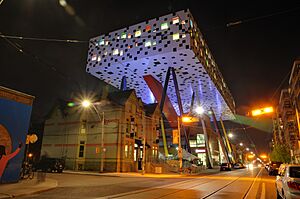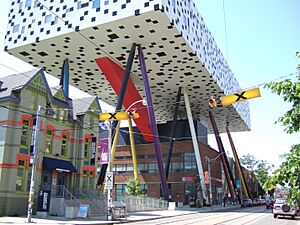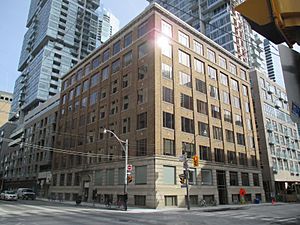OCAD University facts for kids

Logo of the university
|
|
|
Other name
|
OCAD University |
|---|---|
|
Former names
|
Ontario School of Art (1876–86) Toronto Art School (1886–90) Central Ontario School of Art and Industrial Design (1890–1912) Ontario College of Art (1912–96) Ontario College of Art & Design (1996–2010) |
| Type | Public university |
| Established | 4 April 1876 |
| Endowment | C$19.9 million (2022) |
| Chancellor | Jamie Watt |
| President | Ana Serrano |
| Provost | Caroline Langill |
|
Academic staff
|
400 |
| Students | 5,220 (2023) |
| Undergraduates | 4,890 (2023) |
| Postgraduates | 330 (2023) |
| Location |
,
,
Canada
43°39′11″N 79°23′28.3″W / 43.65306°N 79.391194°W |
| Campus | Urban |
| Affiliations | AICAD, COU, Universities Canada |
OCAD University, also known as Ontario College of Art & Design University, is a public university in Toronto, Ontario, Canada. It is a special kind of university that focuses on art and design. Its main campus is located in the Grange Park and Entertainment District areas of Toronto.
OCAD University welcomes both male and female students. It has three main parts, called faculties: the Faculty of Art, the Faculty of Arts and Science, and the Faculty of Design. These faculties offer programs for students who are just starting university and for those who want to continue their studies after their first degree. The university also offers special courses and certificates. OCAD University is one of only four schools outside the United States that are part of the Association of Independent Colleges of Art and Design.
The university was started in 1876 by the Ontario Society of Artists. It was first called the Ontario School of Art. This makes it the oldest school in Canada dedicated to teaching art and design. Over the years, its name changed a few times. In 1912, it became the Ontario College of Art (OCA). Later, in 1945, it started teaching design, and in 1996, it changed its name to the Ontario College of Art and Design (OCAD). In 2010, it officially became a university, changing its name to Ontario College of Art and Design University to show that it could now offer university degrees.
In 2023, about 4,890 students were working on their first university degree, and 330 students were studying for advanced degrees. As of 2022, more than 25,000 people have graduated from OCAD University.
Contents
History of OCAD University
How OCAD University Started
OCAD University began in 1876. The Ontario Society of Artists wanted to offer professional art training. They also wanted to help art education grow in Ontario. On April 4, 1876, the artists decided to create an art school. It opened on October 30, 1876, with $1,000 from the government.
The first school was at 14 King Street West. It had 25 students. Artist Thomas Mower Martin was the first director. Other artists like Robert Harris and William Cruikshank also taught there. William Cruikshank was even the school's president for a few years.
In 1882, the Ontario Department of Education took over the school. It moved to the Toronto Normal School. In 1886, the school moved again to a building near Queen Street and Yonge Street. Its name changed to the Toronto Art School.
The Ontario Society of Artists started sponsoring the school again in 1890. They renamed it the Central Ontario School of Art and Industrial Design. It reopened at the Princess Theatre, which also shared space with the Art Museum of Toronto (now the Art Gallery of Ontario).
Growing in the 1900s
In 1910, the school moved to 1 College Street because the Princess Theatre was torn down. Two years later, the Ontario government allowed the school to give out diplomas. It became the Ontario College of Art, and George Agnew Reid was its first principal. Reid designed the first building owned by the college. It was the first building in Canada made just for teaching artists and designers. The college moved into this new building in 1921. This building is still used today.
Reid wanted visual arts to be a formal part of education. He tried to make OCA part of the University of Toronto, but this plan did not happen.
In 1945, OCA started a design school. This made its teaching wider. By the 1950s, the college had classes in other places too. In 1957, the main campus got its first addition. More additions were built in 1963, 1967, and 1981 as more students joined.
In 1974, the college started a program where students could study in Florence, Italy. They had a special building with art studios there. This program ended in 2017.
From 1979 to 1997, OCA also held classes at the Stewart Building. This building was north of the main campus.
In 1996, the school changed its name to the Ontario College of Art and Design. This change showed that it now included design education. It also helped the school get ready to offer university degrees instead of just diplomas. The next year, the college partnered with the U.K.'s Open University. This allowed students to get an Open University degree.
OCAD University in the 2000s
The 2000s brought big changes to the college. In 2000, money was found to build a large new part of the Main Building. British architect Will Alsop designed a unique "table top" building. This design was chosen in 2002. The new part was finished in 2004. It was named the Sharp Centre for Design after its supporters, Rosalie and Isadore Sharp.
In 2002, the Ontario government gave OCAD university status. This meant it could give out bachelor's degrees in fine arts and design. In 2007, it was allowed to give out graduate degrees. The first graduate students started in 2008. In 2008, the college joined the Association of Universities and Colleges of Canada. In 2009, it started offering courses for people who were not studying for a degree.
In 2010, the school officially became the Ontario College of Art and Design University. On July 1, 2020, the Government of Ontario gave the university full power to give out its own degrees, including special honorary degrees.
OCAD University Campus
OCAD University is located in downtown Toronto. It is not like a typical university with all its buildings in one big area. Instead, its campus is spread out among the city's neighborhoods. The main group of buildings is in the Grange Park neighborhood along McCaul Street. This includes the Main Building, Butterfield Park, the Annex Building, the Rosalie Sharp Pavilion, and other buildings.
Another group of buildings is south of Grange Park, in the Entertainment District. These are at 199, 205, and 230–240 Richmond Street West. OCAD U also has a "waterfront campus" at 130 Queens Quay East.
You can reach the campus easily by public transportation. There are subway stations like St. Patrick and Osgoode. Streetcar routes like the 505 Dundas and 501 Queen also go there.
OCAD U does not have student dorms on campus. However, it helps students find places to live in the city.
Campus Buildings
The buildings at OCAD U are a mix of old and new styles. The oldest buildings are 74–76 McCaul Street, built in 1887. These are old Victorian houses. They are not used for classes but are an art supply store. The George Reid Wing, part of the Main Building, opened in 1921. It was designed by George Agnew Reid, an alumnus and principal. This building has a Georgian style, similar to The Grange manor nearby. Both 74–76 McCaul Street and the George Reid Wing are protected heritage buildings.
Some buildings on Richmond Street West, like 205 and 240 Richmond, are also heritage sites. They used to be brick warehouses in an area called the Garment District. OCAD U bought 205 Richmond in 2007. It bought 240 Richmond and 230 Richmond in 2008. These buildings now hold the university's main offices and services.
Many changes were made to Reid’s original building in the later 1900s. The first addition, the A.J. Casson Wing, opened in 1957. More floors and an atrium were added in 1963, 1967, and 1981.
The newest addition to the Main Building is the Sharp Centre for Design. It opened in 2004. This building looks very different from the older ones. It was designed by British architect Will Alsop. It looks like a black and white box held up by many colorful pillars. This box is 26 meters (about 85 feet) above the ground. It added a lot of new space for the university. The Sharp Centre for Design is famous for its unique look and has won many awards.
Other buildings were added as the college grew. The Annex Building and 49–51 McCaul Street were built in the 1970s. The Annex Building is connected to a small shopping area. A special feature of 49–51 McCaul Street is that it is built around the McCaul Loop, an old streetcar stop. In 1998, a building at the corner of McCaul and Dundas Street was bought. It was named the Rosalie Sharp Pavilion.
In 2016, the university started a big project called Ignite Imagination. It aimed to raise $60 million to update and add new space. The Rosalie Sharp Pavilion was renovated. It now has a cool stainless steel outside that looks like a map of Toronto. This pavilion, along with the Art Gallery of Ontario, acts as a "gateway" to the university.
OCAD University Library
The OCAD University Library is where students and teachers can find books and other materials. It has over 65,000 print books, 76,000 e-books, and many films, videos, and graphic materials.
The library has three main parts: the Dorothy H. Hoover Library, The Learning Zone, and the University Archives. The Dorothy H. Hoover Library is a general library for art and design research. It is named after the university's first head librarian. It is on the second floor of the Annex Building. This library helps students and teachers with their research. It opened in 1987.
The Learning Zone is on the ground floor of the Annex Building. It is an open area for students to study alone or in groups. It also has computers and a collection of zines (small, self-published magazines) made by students. The Dorothy H. Hoover Library is open to the public. However, The Learning Zone and University Archives are mostly for OCAD U students and teachers.
Art Galleries at OCAD U
OCAD University has seven galleries where art is shown. These galleries display art from students, teachers, graduates, and other professional artists. Some galleries are mainly for certain students. For example, graduate students often use the Graduate Gallery.
The Onsite Gallery is the university's public gallery. It shows modern art by Indigenous, Canadian, and international artists. It opened in 2007 as the OCAD Professional Gallery. Its name changed to Onsite Gallery in 2010. The university also works with Partial Gallery to show and sell art from its students and graduates.
Sustainability Efforts
OCAD University has a Sustainability Committee. This group works to make the university's operations more environmentally friendly. In 2009, OCAD U and other universities in Ontario promised to make their campuses models of environmental responsibility. In 2024, the university received a silver rating for its sustainability practices.
Academics at OCAD University
OCAD University is a complete school for art, design, and media. It is the oldest school in Canada focused on these subjects. The school year has two main terms: Fall/Winter (September to April) and Spring/Summer (May to August).
The university has three main faculties: the Faculty of Art, the Faculty of Liberal Arts and Science, and the Faculty of Design. As of 2022, OCAD U offers 18 programs for undergraduate students and seven programs for graduate students. The School of Graduate Studies manages the graduate programs.
In the 2020–21 school year, over 4,100 full-time undergraduate and graduate students were enrolled. In the same year, 2,345 people took courses through OCAD University's School of Continuing Studies. The university had 151 full-time teachers and 294 part-time teachers in 2020–21.
OCAD University gives out different types of degrees. These include Bachelor of Arts, Bachelor of Design, and Bachelor of Fine Arts for undergraduate students. For graduate students, it offers Master of Arts, Master of Design, and Master of Fine Arts. The quality of education is checked by the Ontario University Council on Quality Assurance. OCAD U is also a member of several national and international education groups.
University Rankings
In the 2023 QS World University Rankings for art and design, OCAD U was ranked among the top 51–100 universities out of 238 worldwide.
How to Get In
The requirements to get into OCAD University are different for students from Ontario, other Canadian provinces, and other countries. This is because grading systems vary. Since English is the main language of teaching, students whose first language is not English need to show they are good at English.
OCAD University looks at many things when deciding who to admit. Students usually need a certain average grade. They also often need an interview, a letter explaining why they want to study there, a writing sample, or a portfolio of their art or design work.
In 2017, about 92.2% of first-year students continued to their second year.
Research at OCAD University
As of 2022, OCAD University has over 20 research centers and labs. One important center is the Inclusive Design Research Centre (IDRC). This center focuses on inclusive design, which means making things (like websites or products) easy for everyone to use, including people with disabilities.
In the 2020–21 school year, the university received over $7.2 million for research projects. As of 2022, four teachers at OCAD U are Canada Research Chairs. These are special positions for top researchers in Canada.
The university is part of several research groups and projects. One is the Centre for Innovation in Information Visualization and Data-Driven Design. This project works with York University and the University of Toronto to create new ways to show and understand information. Another group is the Inclusive Design Institute. This group researches inclusive designs for technology.
OCAD University also supports two places that help new businesses grow. These are called the Imagination Catalyst and the Mobile Experience Innovation Centre. The Imagination Catalyst helps students, graduates, and teachers develop their business ideas. The Mobile Experience Innovation Centre focuses on new ideas for mobile technology.
How OCAD University is Run
Leadership and Rules
OCAD University is a public university. It is run by a board of governors and a senate. These groups get their power from a provincial law called the Ontario College of Art and Design University Act. This law was last changed in 2010 when the university got its current name. The changes also made the role of the university chancellor official.
Board of Governors and Senate
The board of governors manages the university's business and makes big decisions. It has 18 members. Some are chosen by the government, and two are elected by OCAD University graduates. Eight members come from the university itself, including teachers and student representatives.
The senate is in charge of the university's education rules. Most of its members are teachers, but it also includes people from the university's administration and student leaders.
The chancellor is the official head of the university. The board of governors chooses the chancellor for a four-year term. Jamie Watt is the current chancellor, starting in 2022. The board also chooses the university president. The president is the main leader of the university and is in charge of its daily operations. The president is also the head of the senate. Ana Serrano is the current president, starting in July 2020.
Indigenous Education Council
The Indigenous Education Council was created at the university in 2008. Its goal is to work with Indigenous communities and governments. It helps more Indigenous students get into the university, stay in school, and finish their degrees. The council is made up of volunteers who represent Indigenous interests. It helps make sure Indigenous voices are heard in university decisions.
Student Life at OCAD University
| Undergraduate | Graduate | |
|---|---|---|
| Male | 26.6% | 25.3% |
| Female | 66.0% | 68.6% |
| Canadian student | 73.4% | 64.9% |
| International student | 26.6% | 35.1% |
In 2022, OCAD University had 4,721 undergraduate students and 316 graduate students. Most students (about 73%) are Canadian citizens. Many Canadian students get financial help through government loan programs, like Canada Student Loans or the Ontario Student Assistance Program. In the 2019–20 school year, about 67% of new full-time undergraduate students received some financial aid. On average, they received $6,830.
The OCAD Student Union (OCADSU) represents the students. It is part of the Canadian Federation of Students. The union's offices are at 230 Richmond. They offer services like helping students with academic issues, a food bank, legal advice, and student grants. Besides the OCADSU, there are many other student groups at the university. These groups focus on different cultures, social activities, and hobbies.
University Symbols
The university has used a logo to identify itself since at least 1903. It has had at least nine different logos over the years. The current logo was introduced in 2011. This was around the same time the school changed its name to OCAD University in 2010. The 2011 logo was designed by Bruce Mau Design.
Famous People from OCAD University
Many people are connected to OCAD University. They might be graduates, or they might have worked as teachers or administrators. As of 2022, over 25,000 people have graduated from OCAD University around the world. Graduates can join the OCAD Alumni Association, which is a group for OCAD graduates.
Several graduates and teachers have become very famous in art and design. This includes all the original members of the Group of Seven: Franklin Carmichael, A. J. Casson, A. Y. Jackson, Franz Johnston, Arthur Lismer, J. E. H. MacDonald, and Frederick Varley. Other notable people include members of the Canadian Group of Painters and the Painters Eleven, such as Anna Savage, George Pepper, Yvonne McKague Housser, Jack Bush, and Harold Town.
Other well-known alumni and faculty members include Barbara Astman, Aba Bayefsky, J. W. Beatty, David Blackwood, David Bolduc, Dennis Burton, Ian Carr-Harris, Charles Comfort, Graham Coughtry, Greg Curnoe, Ken Danby, Azadeh Elmizadeh, Allan Fleming, Richard Gorman, Fred S. Haines, Charles William Jefferys, Burton Kramer, Nobuo Kubota, Isabel McLaughlin, Lucius Richard O'Brien, Joanna Pocock, John Scott, Michael Snow, Lisa Steele, Colette Whiten, and Agnes Chow.
See also
- Education in Toronto
- Higher education in Ontario
- List of art schools
- List of universities in Ontario








